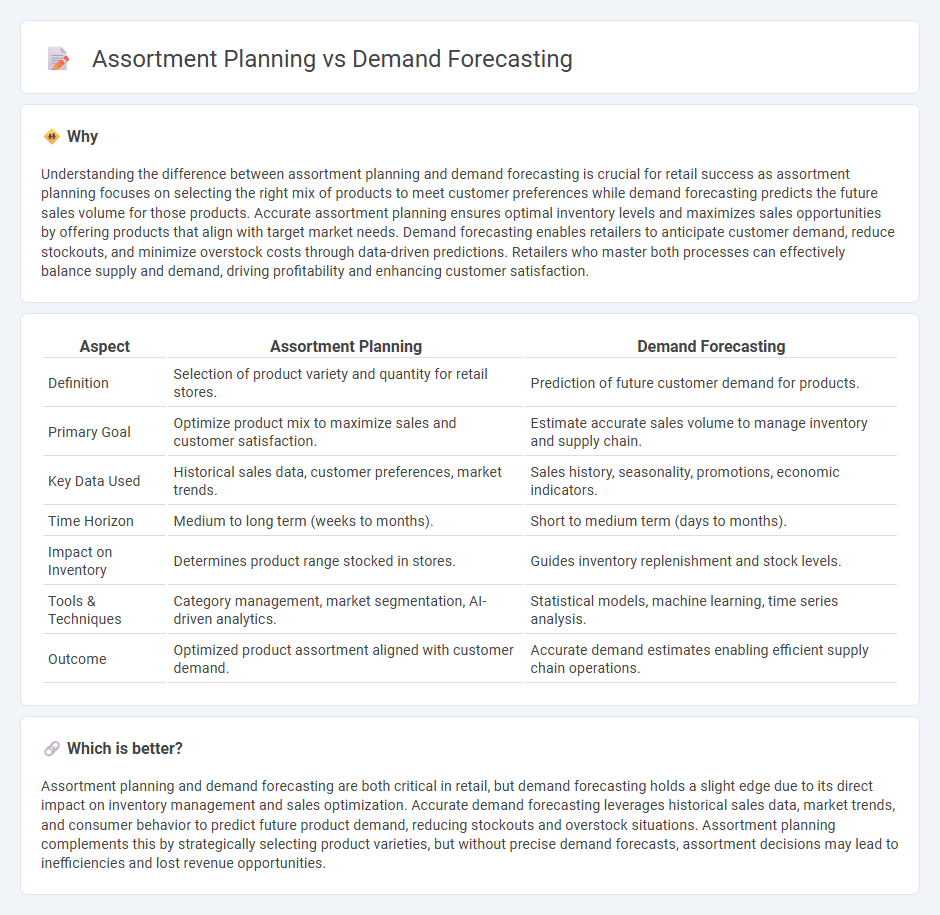
Assortment planning focuses on selecting the right mix of products to meet customer preferences and maximize sales, while demand forecasting predicts future consumer demand using historical data and market trends. Effective retail strategies integrate both to optimize inventory levels, reduce stockouts, and increase profitability. Explore deeper insights into how these processes transform retail operations and drive business growth.
Why it is important
Understanding the difference between assortment planning and demand forecasting is crucial for retail success as assortment planning focuses on selecting the right mix of products to meet customer preferences while demand forecasting predicts the future sales volume for those products. Accurate assortment planning ensures optimal inventory levels and maximizes sales opportunities by offering products that align with target market needs. Demand forecasting enables retailers to anticipate customer demand, reduce stockouts, and minimize overstock costs through data-driven predictions. Retailers who master both processes can effectively balance supply and demand, driving profitability and enhancing customer satisfaction.
Comparison Table
| Aspect | Assortment Planning | Demand Forecasting |
|---|---|---|
| Definition | Selection of product variety and quantity for retail stores. | Prediction of future customer demand for products. |
| Primary Goal | Optimize product mix to maximize sales and customer satisfaction. | Estimate accurate sales volume to manage inventory and supply chain. |
| Key Data Used | Historical sales data, customer preferences, market trends. | Sales history, seasonality, promotions, economic indicators. |
| Time Horizon | Medium to long term (weeks to months). | Short to medium term (days to months). |
| Impact on Inventory | Determines product range stocked in stores. | Guides inventory replenishment and stock levels. |
| Tools & Techniques | Category management, market segmentation, AI-driven analytics. | Statistical models, machine learning, time series analysis. |
| Outcome | Optimized product assortment aligned with customer demand. | Accurate demand estimates enabling efficient supply chain operations. |
Which is better?
Assortment planning and demand forecasting are both critical in retail, but demand forecasting holds a slight edge due to its direct impact on inventory management and sales optimization. Accurate demand forecasting leverages historical sales data, market trends, and consumer behavior to predict future product demand, reducing stockouts and overstock situations. Assortment planning complements this by strategically selecting product varieties, but without precise demand forecasts, assortment decisions may lead to inefficiencies and lost revenue opportunities.
Connection
Assortment planning and demand forecasting are interconnected processes essential for optimizing retail inventory and sales performance. Demand forecasting provides data-driven insights into customer purchasing patterns, enabling retailers to curate product assortments that meet anticipated consumer needs. Effective integration of these strategies reduces stockouts, minimizes excess inventory, and enhances overall supply chain efficiency.
Key Terms
Sales Data Analysis
Sales data analysis in demand forecasting involves predicting future customer demand to optimize inventory levels and reduce stockouts. In assortment planning, sales data guides the selection and variety of products offered to meet market preferences and maximize sales revenue. Explore deeper techniques and tools to enhance accuracy in both areas.
SKU Optimization
Demand forecasting analyzes historical sales data and market trends to predict future product demand, enabling accurate inventory management for each SKU. Assortment planning evaluates product variety and shelf space allocation to optimize the mix of SKUs, maximizing sales and customer satisfaction. Explore how integrating demand forecasting with assortment planning enhances SKU optimization and drives retail success.
Inventory Levels
Demand forecasting predicts future customer demand using historical sales data and market trends to optimize inventory levels and minimize stockouts or overstock situations. Assortment planning involves selecting the right mix of products to meet customer preferences while balancing inventory costs and shelf space constraints. Explore how integrating demand forecasting with assortment planning enhances inventory management efficiency.
Source and External Links
Types of Demand Forecast - GeeksforGeeks - Demand forecasting uses predictive analysis of historical data to estimate future customer demand, aiding businesses in inventory planning, production, and operational decisions through various forecasting types like active, external macro, and trend projection.
Demand forecasting - Wikipedia - Demand forecasting predicts the quantity of goods or services consumers will require at a future time using qualitative methods based on expert opinions and quantitative methods using data analytics, helping optimize supply chains and business decisions.
Demand Forecasting Guide: Definition, Types, Methods, Examples - Common demand forecasting methods include trend projection using past sales data, market research via customer surveys, and sales force composite that leverages sales team's customer insights to predict future product demand.
 dowidth.com
dowidth.com